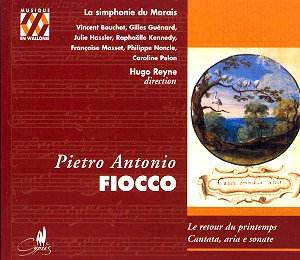Many Italian composers
of the 17th century went abroad to look
for a job. Most of them travelled to
Austria or Germany, but some took another
direction. The best-known of them was
Giovanni Battista Lulli, who as Jean-Baptiste
Lully dominated musical life in France
in the second half of the 17th century.
Another was Pietro Antonio Fiocco, who
stayed the largest part of his life
in the Southern Netherlands.
Fiocco was born in
Venice, where he probably received his
first music lessons from his father
Giaconto, a surgeon-barber, who played
in the city’s marine corps. The first
traces of his musical activities have
been found in Amsterdam, where his 'Helena
rapita da Parida' was performed in the
recently founded opera in May 1681.
Because of financial problems the Amsterdam
opera had to close, and it seems Fiocco
went to Hanover, where his opera was
performed in June of that same year.
Brussels, the capital
of the Southern Netherlands, saw the
next - and final - stage in his career.
There he married for the second time
in 1682; his first wife and newly-born
daughter had died in Amsterdam. He got
three children, one of whom became a
composer: Jean-Joseph Fiocco. After
his second wife had died, he married
a third time in 1692, and from this
marriage he got 11 children, among them
another son who was to become a composer:
Joseph Hector Fiocco. Pietro Antonio
remained in the Southern Netherlands
until his death in 1714.
In Brussels he played
a crucial role in the foundation of
an opera. Since 1681 attempts had been
made to establish a permanent opera
house, but due to financial problems
and obstruction from the authorities
these attempts had failed. Thanks to
an Italian financier and the support
of the new governor, who was a great
lover of music, from 1694 on Fiocco
performed a number of works for the
theatre. These included operas by Lully:
Amadis (1695), Phaéton (1696),
Armide and Thésée (1697).
In 1700 the opera was formally established,
and received the name of 'Théâtre
sur la Monnaie' exists to this day.
The compositions featured
on this disc reflect Fiocco’s two styles.
We start with a pastorale modelled after
the operas of Lully. Lully's operas
are imitated, sometimes even quoted.
While Lully made use of the recitative
Fiocco preferred arias or ariettas.
The vocal items here are interspersed
with instrumental movements, just like
the French ballet-operas. Towards the
end, before the concluding duet and
chorus, we hear a long chaconne.
The pastorale was recorded
live during a performance in the very
same theatre where it was first performed
in 1699. The acoustics are very appropriate,
much more so than those of a studio.
And I am happy to say that on the whole
the performance is rather good, the
sopranos and the baritone in particular.
Gilles Guenard's voice is not very strong,
and as a result the balance between
Guenard (as shepherd) and Julie Hassler
(as shepherdess) in the duet 'Aimez,
jeunes amants' is less than ideal. I
also wondered about Philippe Noncle,
who is mentioned in the booklet as an
haute-contre, but doesn't sound like
one to me, as his upper register isn't
very strong. He has some problems in
hitting the top notes of his part. The
adoption of modern style French pronunciation
is disappointing.
The other items on
the disc were recorded in the studio.
The two vocal pieces are examples of
music in Italian style: a solo cantata,
consisting of two arias, connected by
a recitative. There’s also an aria which
was originally part of Fiocco's 'burletta
per musica' - a kind of comic opera
- Coridone scultore, staged in Brussels
in 1697, the score of which has been
lost. Fiocco also composed chamber music:
the sonata in G minor comes from a collection
of sonatas by Fiocco, Pez, Pepusch and
Croft, which was published in 1706 by
Estienne Roger in Amsterdam. The sonata
in C was discovered by Hugo Reyne in
a copy by the French bassoonist Charles
Babel. He performs these sonatas here,
and although his playing is generally
good, I don't like the slight wobble
he seems to favour. The same is true
for the soprano Françoise Masset,
who performs the cantata and the aria,
which are nice to hear, but too short
to make a lasting impression. This is
perhaps the best way to assess Fiocco's
music and therefore this disc: it is
nice to listen to - and interesting
from a historical perspective - but
probably not something I shall return
to regularly.
Johan van Veen







